Wiki
Clone wikiosiris / Demos
- Demo 1 : Simple 2D slice
- Demo 2 : Binning cells in a 2D histogram
- Demo 3 : New variable field and scatter plot
- Demo 4 : Center domain around max density and plot slice with streamlines
- Demo 5 : Density slice at arbitrary angle with coloured velocity vectors
- Demo 6 : Automatic "top" slice orientation according to angular momentum
- Demo 7 : Automatic "side" slice orientation according to angular momentum
- Demo 8 : Subplots, slices and contours
- Demo 9 : Plot only a subset of cells belonging to a disk
- Demo 10 : Difference between two snapshots
- Demo 11 : ISM tables for equation of state (EOS), opacities and resistivities
- Demo 12 : Make a thick slice
- Demo 13 : Slice above the origin
- Demo 14 : Make a histogram with mass colormap
- Demo 15 : Demo from the README with histogram and slice subplots
- Demo 16 : Color slice vectors with custom field
- Demo 17 : Radial profile
Demo 1 : Simple 2D slice
Load output number 71 and create a 2D slice of the logarithm of density 100 au wide through the data at z=0 centered around the highest density point, with velocity vectors.
#!python import osiris mydata = osiris.RamsesData(71,scale="au") osiris.plot_slice(mydata.log_rho,direction="z",vec=mydata.velocity,dx=100)
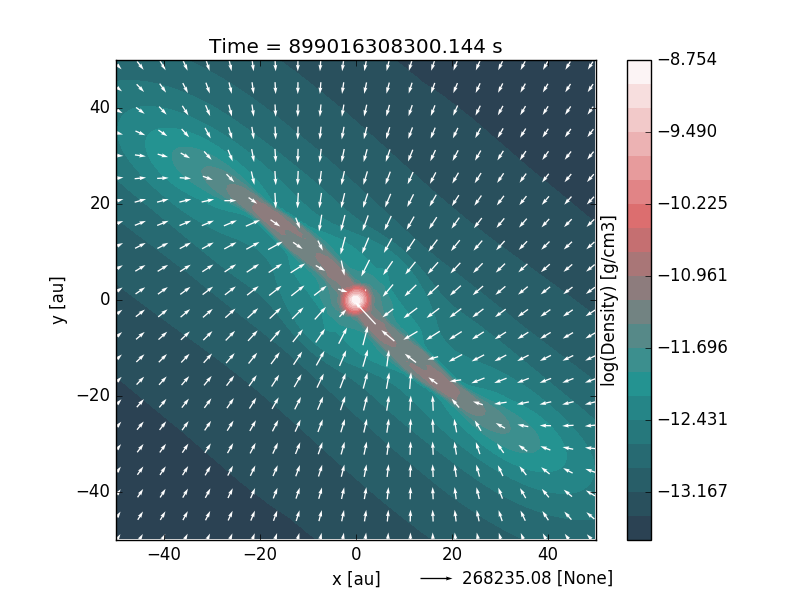
Demo 2 : Binning cells in a 2D histogram
Load output number 71 and create a 2D histogram of the number of cells in the log(density)-log(T) plane.
#!python import osiris mydata = osiris.RamsesData(71) osiris.plot_histogram(mydata.log_rho,mydata.log_T,scalar_args={"cmap":"log"})
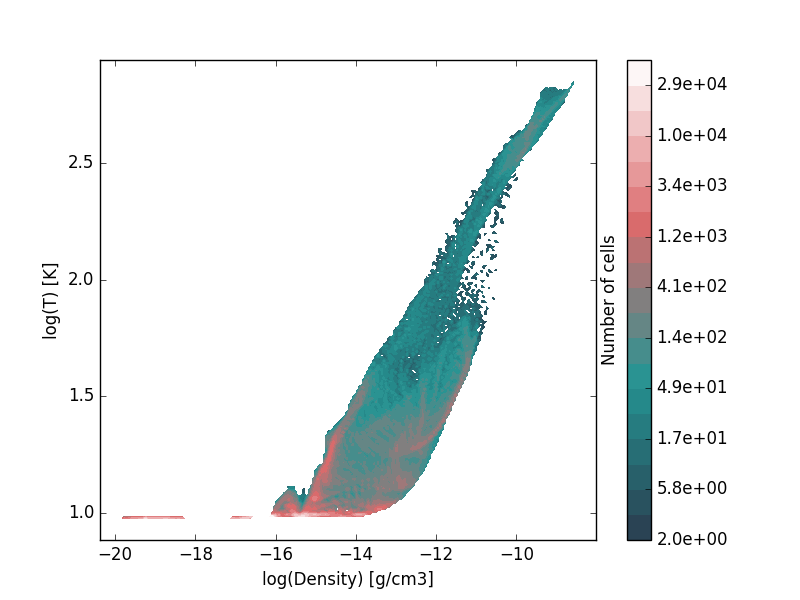
Demo 3 : New variable field and scatter plot
Load output number 71 and create a 2D scatter plot of log(velocity) as a function of log(density). We plot only one cell out of 100, use a new colormap which represents log(T), and include a grey outline around all the data points.
#!python import osiris mydata = osiris.RamsesData(nout=71,center=[0.5,0.5,0.5],scale="au") mydata.new_field(name="log_vel",operation="np.log10(np.sqrt(velocity_x**2+velocity_y**2+velocity_z**2))",unit="cm/s",label="log(Velocity)") osiris.plot_histogram(mydata.log_rho,mydata.log_vel,scatter=mydata.log_T,outline=True,scatter_args={"iskip":100,"cmap":"gnuplot"})
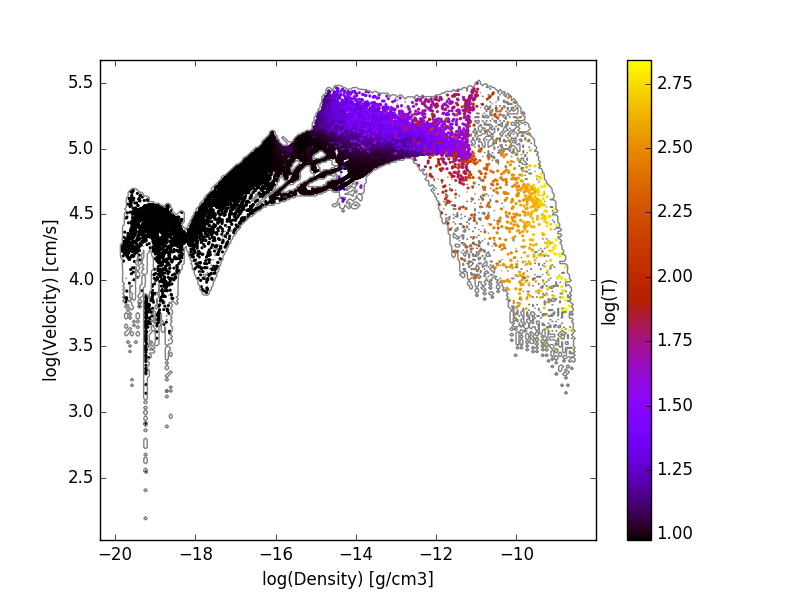
Demo 4 : Center domain around max density and plot slice with streamlines
Load output number 71 and create a 2D slice of the logarithm of density 100 au wide through the data at y=0 centered around the highest density point, with magnetic field streamlines. Color the streamlines logarithmically with a new colormap. Set the time unit to kyr.
#!python import osiris osiris.conf.default_values["time_unit"]="kyr" mydata = osiris.RamsesData(nout=71,center="max:density",scale="au") osiris.plot_slice(mydata.log_rho,direction="y",stream=mydata.B,dx=100,stream_args={"cmap":"log,jet"})
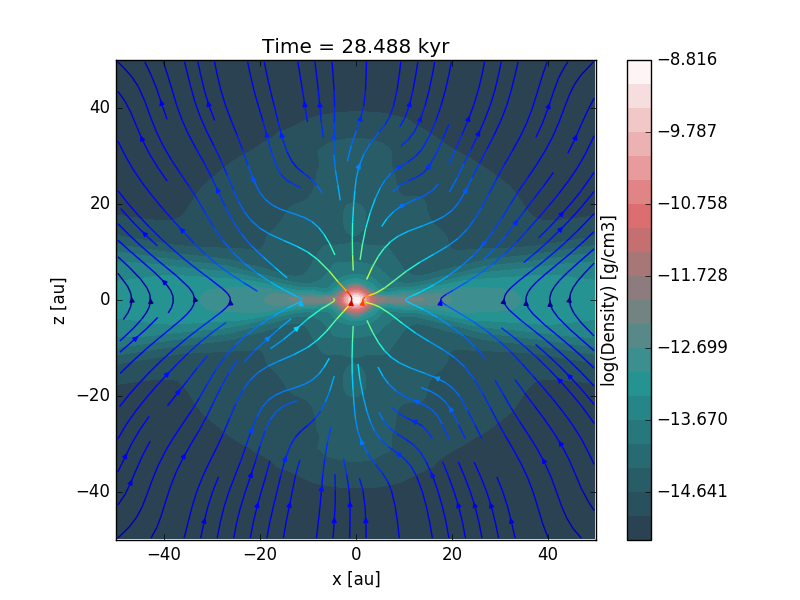
Demo 5 : Density slice at arbitrary angle with coloured velocity vectors
Load output number 71 and create a 2D slice of the logarithm of density 100 au wide centered around the highest density point. The direction of the slicing plane is specified by the normal vector to the plane [-1,1,1]. Velocity vectors in km/s are overlayed. Color the vectors with a new colormap and increase the number of vectors to be plotted by decreasing the vskip value from its default 9 down to 4. Finally add a colorbar for vectors.
#!python import osiris osiris.conf.default_values["time_unit"]="kyr" mydata = osiris.RamsesData(nout=71,center="max:density",scale="au") mydata.new_field(name="vkms",operation="velocity/1.0e5",unit="km/s",label="Velocity") osiris.plot_slice(mydata.log_rho,direction="[-1,1,1]",vec=mydata.vkms,dx=100,vec_args={"cmap":"jet","vskip":4,"cbar":True})
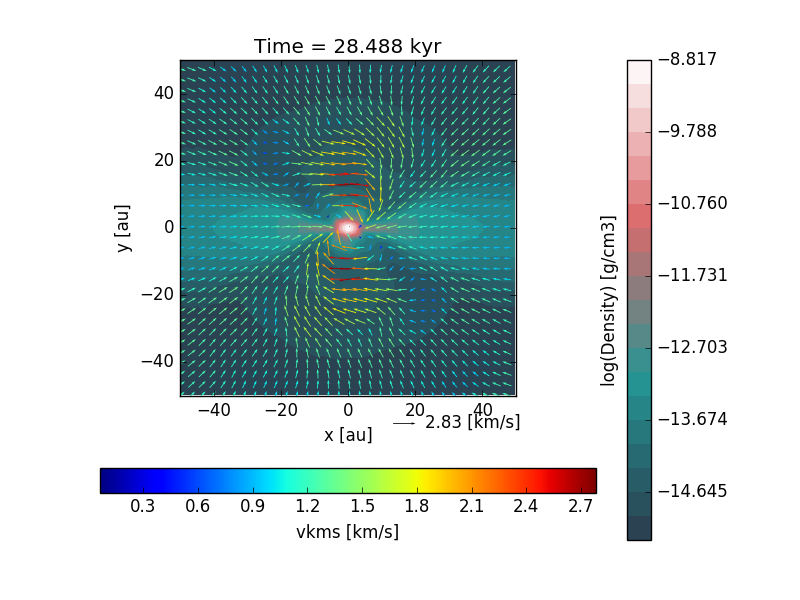
Demo 6 : Automatic "top" slice orientation according to angular momentum
Load output number 71 and create a 2D slice of the logarithm of density 100 au wide through the data using automatic orientation based on the angular momentum in the data. This is useful for looking at disks. Use the "auto:top" direction for the slice to view the disk from above.
#!python import osiris mydata = osiris.RamsesData(nout=71,center="max:density",scale="au") osiris.plot_slice(mydata.log_rho,direction="auto:top",vec=mydata.velocity,dx=100)
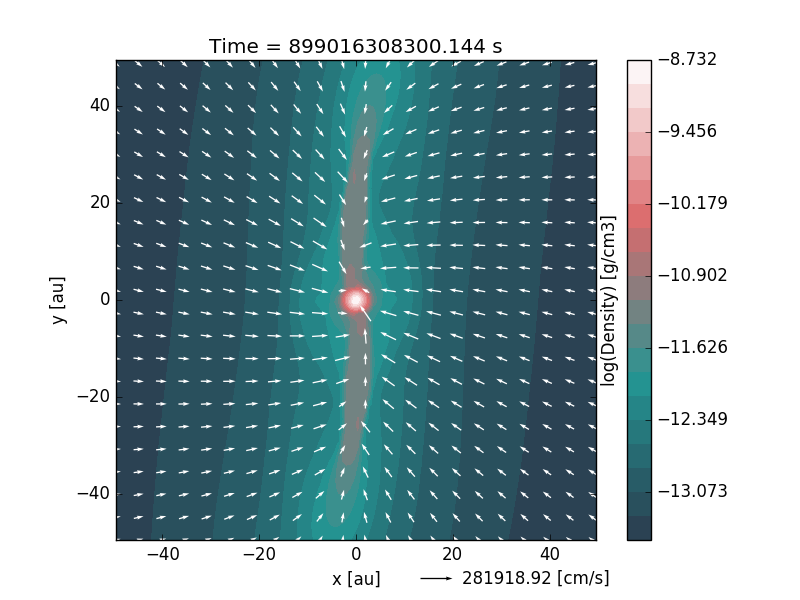
Demo 7 : Automatic "side" slice orientation according to angular momentum
Load output number 71 and create a 2D slice of the logarithm of density 100 au wide through the data using automatic orientation based on the angular momentum in the data. This is useful for looking at disks. Use the "auto:side" direction for the slice to view the disk from the side.
#!python import osiris mydata = osiris.RamsesData(nout=71,center="max:density",scale="au") osiris.plot_slice(mydata.log_rho,direction="auto:side",vec=mydata.velocity,dx=100)
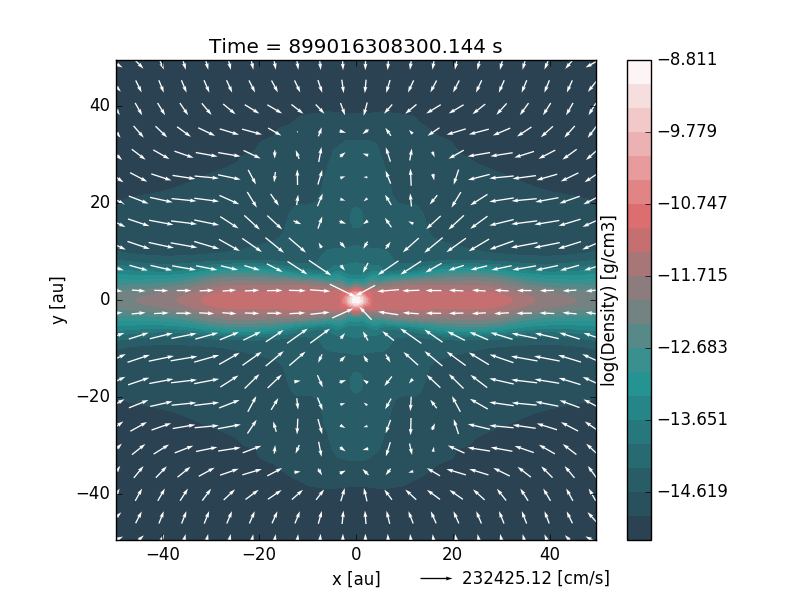
Demo 8 : Subplots, slices and contours
In this example, we create two subplot axes with matplotlib. We load output number 71, setting the center as the mean position of all the cells with a density above 1.0e-10 g/cm3. We also only load a cube of 20 AU in size, instead of loading the entire data into the RAM.
Next, we create a velocity field in km/s for better plotting. We then plot in the left panel the log of density as a coloured slice with kms velocity vectors. The minimum and maximum of log(density) is forced to -14 and -9, and we used 40 colours instead of the default 20. We give the plot_slice call the axes to use via the axes argument. The vectors are scaled to 2km/s, and the key is moved inside the axes.
Next, we overlay some custom chosen density contours with different line styles and colours.
In the right panel, we plot a slice of temperature and overlay some lightgray contours showing the AMR levels. We label the contours with "label":True and set the format to integers with "fmt":"%i".
#!python import osiris # Create figure fig = osiris.plt.figure() ratio = 0.35 sizex = 15.0 fig.set_size_inches(sizex,ratio*sizex) ax1 = fig.add_subplot(121) ax2 = fig.add_subplot(122) # Load data mydata = osiris.RamsesData(nout=71,center="av:density>1.0e-10",scale="au",dx=20.0,dy=20.0,dz=20.0) # Create velocity field in km/s mydata.new_field(name="vkms",operation="velocity/1.0e5",unit="km/s",label="Velocity") # Define region to plot dx = 15.0 # Left plot: coloured density slice with overlayed contours osiris.plot_slice(mydata.log_rho,direction="z",dx=dx,axes=ax1,scalar_args={"extend":"both","vmin":-14.0,"vmax":-9.0,"nc":40},\ vec=mydata.vkms,vec_args={"vscale":2.0,"vkey_pos":[0.65,0.1]},\ contour=mydata.log_rho,contour_args={"levels":[-12.0,-11.0,-9.0],"colors":('yellow','k',"lime"),\ "linewidths":[2,5,2],"linestyles":["solid","dashed","solid"],"cmap":None,"cbar":False},title="My title") # Right plot: temperature slice with AMR levels osiris.plot_slice(mydata.log_T,direction="z",dx=dx,axes=ax2,title="",scalar_args={"cmap":"hot"},\ contour=mydata.level,contour_args={"fmt":"%i","colors":"lightgray","cmap":None,\ "levels":range(12,20),"label":True,"cbar":False}) # Save figure to pdf file fig.savefig('myplot.png')

Demo 9 : Plot only a subset of cells belonging to a disk
In this example, we select cells according to their density and plot only those. This is done by creating a new field and using the numpy where function. To combine more than one selection criteria, use the logical_and numpy function. This is useful for plotting disks around protostars, for example. Here we select the cells with a density in the range -12.5 < log(density) < -11.0. After plotting the disk, we use 2 different methods to compute the disk mass.
#!python import osiris import numpy as np # Load data mydata = osiris.RamsesData(nout=71,center="max:density",scale="au",dx=100.0,dy=100.0,dz=100.0) mydata.new_field(name="log_rho_disk",values=np.where(np.logical_and(mydata.get("log_rho") > -12.5,\ mydata.get("log_rho") < -11.0),mydata.get("log_rho"),np.NaN),label="Disk density") osiris.plot_slice(mydata.log_rho_disk,direction="z",dx=50) # Now print disk mass: 2 different ways # Method 1: cube = np.where(np.logical_and(mydata.get("log_rho") > -12.5,mydata.get("log_rho") < -11.0)) mcore1 = np.sum(mydata.mass.values[cube]) # Method 2: mydata.new_field(name="disk_mass",values=np.where(np.logical_and(mydata.get("log_rho") > -12.5,\ mydata.get("log_rho") < -11.0),mydata.get("mass"),np.NaN),label="Disk mass") mcore2 = np.nansum(mydata.disk_mass.values) print("Disk mass: %.3e Msun ; %.3e Msun"%(mcore1,mcore2))

Demo 10 : Difference between two snapshots
Here, we want to make a map of the difference in density between two snapshots. Because we do not necessarily have the same number of cells at the same place, we first have to make uniform 2D maps using the plot_slice function, which we can then directly compare. This is done by calling plot_slice with the arguments plot=False to avoid making a plot, and copy=True to return the data to a variable.
#!python import osiris import numpy as np # Read data from 2 snapshots mydata1 = osiris.RamsesData(71,scale="au") mydata2 = osiris.RamsesData(201,scale="au") # Extract log(density) slices by copying data into structures slice1 = osiris.plot_slice(mydata1.log_rho,direction="z",dx=100,plot=False,copy=True) slice2 = osiris.plot_slice(mydata2.log_rho,direction="z",dx=100,plot=False,copy=True) # Get coordinates x = slice1[0] y = slice1[1] # Get densities rho1 = slice1[2] rho2 = slice2[2] # Density difference diff = (rho1-rho2)/rho2 # Create figure fig = osiris.plt.figure() ax1 = fig.add_subplot(111) im1 = ax1.contourf(x,y,diff,cmap='RdBu',levels=np.linspace(-0.12,0.12,31)) ax1.set_aspect("equal") cb = osiris.plt.colorbar(im1,ax=ax1) cb.ax.set_ylabel('Relative difference') fig.savefig("diff.png")
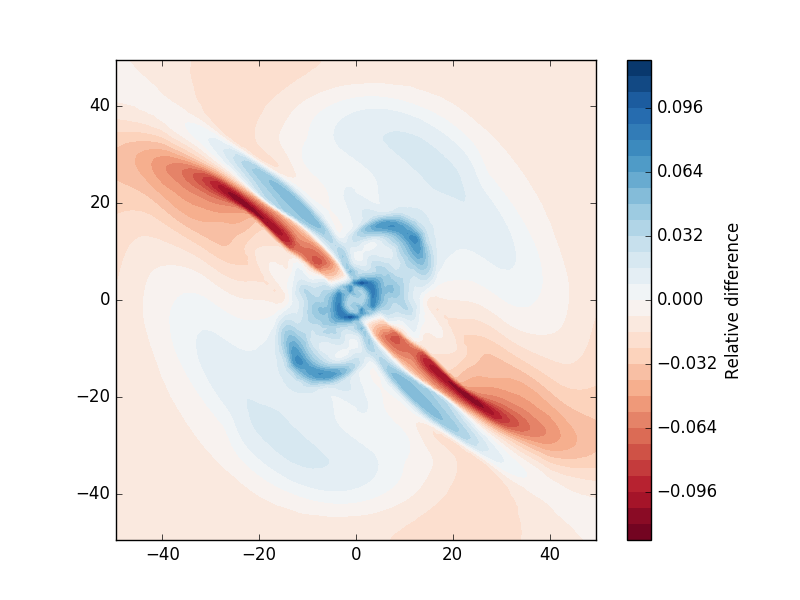
Demo 11 : ISM tables for equation of state (EOS), opacities and resistivities
We load the EOS, opacities and resistivities tables and plot them as a function of gas density.
#!python import osiris import numpy as np # Create figure fig = osiris.plt.figure() ratio = 0.25 sizex = 20.0 fig.set_size_inches(sizex,ratio*sizex) ax1 = fig.add_subplot(131) ax2 = fig.add_subplot(132) ax3 = fig.add_subplot(133) # Load data mydata = osiris.RamsesData(nout=50,scale="au",verbose=True) # Read EOS table and plot sound speed histogram osiris.ism_physics.get_eos(mydata,fname="SCvH_eos.dat") mydata.new_field(name="log_cs",operation="np.log10(cs_eos)",label="log(cs)",unit="cm/s") osiris.plot_histogram(mydata.log_rho,mydata.log_cs,scalar_args={"cmap":"log,Greens","cbar":False},outline=True,axes=ax1,title="Equation of state") # Read opacity table and plot Rosseland mean opacity osiris.ism_physics.get_opacities(mydata) mydata.new_field(name="log_kr",operation="np.log10(kappa_r)",label="log(Kr)",unit="cm2/g") osiris.plot_histogram(mydata.log_T,mydata.log_kr,scalar_args={"cmap":"log,Blues","cbar":False},outline=True,axes=ax2,title="Opacities") # Read resistivity table and plot Ohmic and Ambipolar osiris.ism_physics.get_resistivities(mydata) mydata.new_field(name="log_etaO",operation="np.log10(eta_ohm)",label="log(etaO)") mydata.new_field(name="log_etaA",operation="np.log10(eta_ad)",label="log(etaA)") osiris.plot_histogram(mydata.log_rho,mydata.log_etaO,scalar_args={"cmap":"log,Greys","cbar":False},outline=True,axes=ax3,title="") osiris.plot_histogram(mydata.log_rho,mydata.log_etaA,scalar_args={"cmap":"log,Reds","cbar":False},outline=True,axes=ax3,title="Resistivities") ax3.set_ylabel("log(eta) [s]") ax3.text(-16.0,0.0,"Ambipolar",va="center",ha="center") ax3.text(-12.0,-4.0,"Ohmic",va="center",ha="center") fig.savefig('ism_tables.png')

Demo 12 : Make a thick slice
We want to plot the average value of density inside a slice with a thickness of 20 AU. For this, we use the plot_column_density function with the summed=False option. We also set the number of samples along the slice thickness direction to 5 using nz=5 to speed up the process (by default nz equals the resolution in x and y). We also plot velocity vectors which are the average of the velocity field along the line of sight. Remember to check for convergence by increasing nz to make sure you have similar results with a lower nz.
#!python import osiris mydata = osiris.RamsesData(nout=71,center="max:density",scale="au") osiris.plot_column_density(scalar=mydata.density,direction="z",vec=mydata.velocity,dx=100,dz=20,scalar_args={"cmap":"log"},nz=5,summed=False)
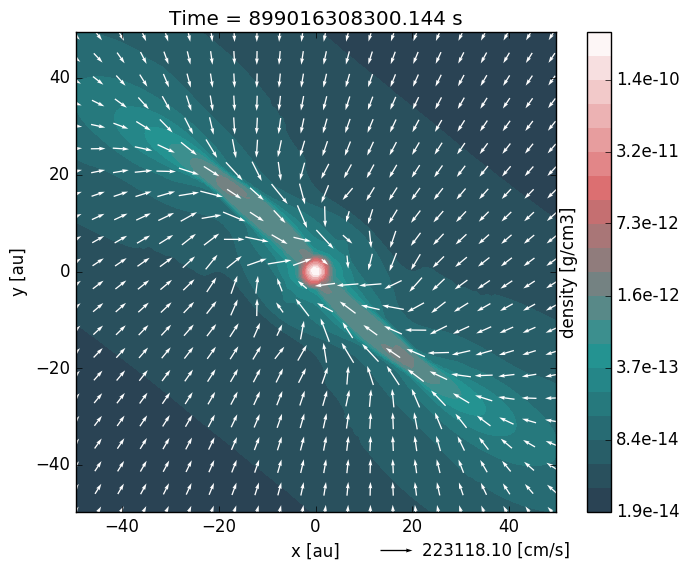
Demo 13 : Slice above the origin
We want to plot a slice of density but through a point which is 5 AU above the centre of the domain, defined as the cell with the highest density. This is done by setting the origin coordinate to [0,0,5].
#!python import osiris mydata = osiris.RamsesData(nout=71,center="max:density",scale="au") osiris.plot_slice(scalar=mydata.density,direction="z",vec=mydata.velocity,dx=100,origin=[0,0,5],scalar_args={"cmap":"log"})

Demo 14 : Make a histogram with mass colormap
Here we create a histogram of log(density) vs log(temperature) using the mass contained in each pixel as the colormap. We want to sum the mass in each pixel, so we use the option summed=True.
#!python import osiris mydata = osiris.RamsesData(nout=71,center="max:density",scale="au") osiris.plot_histogram(mydata.log_rho,mydata.log_T,mydata.mass,summed=True,scalar_args={"cmap":"magma_r,log"})
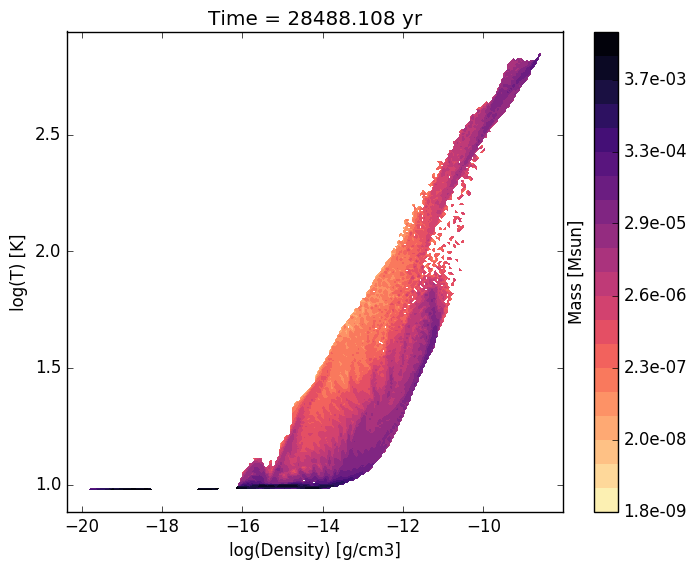
Demo 15 : Demo from the README with histogram and slice subplots
We make six subplots.
#!python import osiris # Change default time unit to kyr osiris.conf.default_values["time_unit"]="kyr" # Load data mydata = osiris.RamsesData(nout=71,center="max:density",scale="au") # Create figure fig = osiris.plt.figure() ratio = 0.5 sizex = 20.0 fig.set_size_inches(sizex,ratio*sizex) ax1 = fig.add_subplot(231) ax2 = fig.add_subplot(232) ax3 = fig.add_subplot(233) ax4 = fig.add_subplot(234) ax5 = fig.add_subplot(235) ax6 = fig.add_subplot(236) # Density vs B field with AMR level contours osiris.plot_histogram(mydata.log_rho,mydata.log_B,axes=ax1,scalar=True,scalar_args={"cmap":"log,YlGnBu"},contour=mydata.level,contour_args={"fmt":"%i","label":True,"colors":"k","cmap":None,"levels":range(5,20),"cbar":False}) # Create new field with log of velocity mydata.new_field(name="log_vel",operation="np.log10(np.sqrt(velocity_x**2+velocity_y**2+velocity_z**2))",unit="cm/s",label="log(Velocity)") # Density vs log_vel in scatter mode with a grey outline osiris.plot_histogram(mydata.log_rho,mydata.log_vel,axes=ax2,scatter=mydata.log_T,scatter_args={"iskip":100,"cmap":"gnuplot"},outline=True) #x,z density slice with B field streamlines osiris.plot_slice(mydata.density,direction="y",stream=mydata.B,dx=100,axes=ax3,scalar_args={"cmap":"log"}) # x,y density slice with velocity vectors in color osiris.plot_slice(scalar=mydata.log_rho,direction="z",vec=mydata.velocity,dx=100,axes=ax4,vec_args={"cmap":"seismic","vskip":4}) # x,y temperature slice with velocity vectors osiris.plot_slice(mydata.log_T,direction="z",vec=mydata.velocity,dx=100,axes=ax5,scalar_args={"cmap":"hot"},contour=mydata.level,contour_args={"fmt":"%i","label":True,"colors":"w","cmap":None,"levels":range(9,17)}) # Now update values with later snapshot mydata.update_values(201) # Re-plot x,y density slice with velocity vectors osiris.plot_slice(mydata.log_rho,direction="auto:top",vec=mydata.velocity,dx=100,axes=ax6) fig.savefig("demo.pdf",bbox_inches="tight")

Demo 16 : Color slice vectors with custom field
We plot a log10(Density) scalar field. We overlay vectors that represent the magnetic field direction but are coloured with the magnitude of the velocity instead of the B field. We first create a new field to represent the velocity in km/s mydata.vkms. Then we set "colors":mydata.vkms in vec_args.
We remove the arrow heads by setting "headwidth":1,"headlength":0. We want all vector segments to have the same length, so we normalize them with "normalize_arrows":True, and we make them a little thicker with "width":0.01.
Warning: in vec_args, colors is for a new field for the colormap, whereas color is a single color (e.g. 'white') for coloring the arrows.
#!python import osiris # Change default time unit to kyr osiris.conf.default_values["time_unit"]="kyr" # Load data mydata = osiris.RamsesData(nout=71,center="max:density",scale="au",verbose=True) mydata.new_field(name="vkms",operation="velocity/1.0e5",unit="km/s",label="Velocity") osiris.plot_slice(scalar=mydata.log_rho,direction="y",vec=mydata.B,dx=100,scalar_args={"cmap":"Blues"},\ vec_args={"cmap":"YlOrRd","colors":mydata.vkms,"normalize_arrows":True,"vkey":False,"scale":25.0,"cbar":True,"width":0.01,"headwidth":1,"headlength":0})
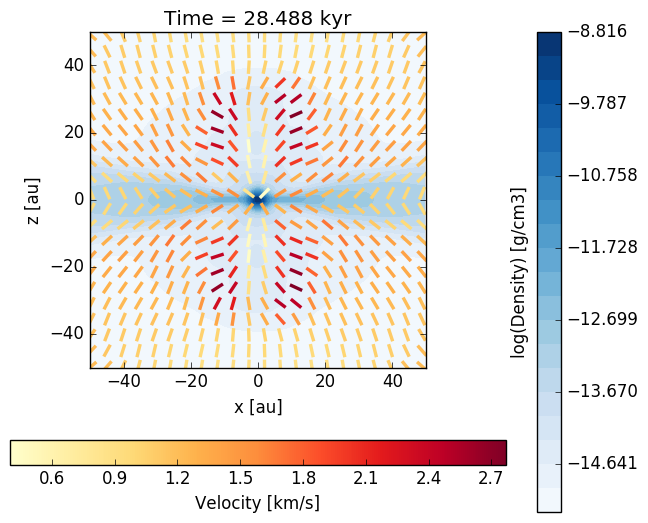
Demo 17 : Radial profile
We can use the plot_histogram function to create a radial density profile. The radial coordinate r and its logarithm log_r are by default calculated when a Ramses output is loaded. By plotting the density as a function of radius as a scatter plot in plot_histogram, we get the figure below (iskip is used to plot 1 in every 100 points to limit the size of the figure). We also overlay the mean radial profile by binning the data radially and computing the mean density in each bin. This is drawn on the figure using the usual matplotlib plotting functions. Note that the mean profile uses the full data set, not just one in every 100 points.
#!python import matplotlib.pyplot as plt import numpy as np import osiris # Change default time unit to kyr osiris.conf.default_values["time_unit"]="kyr" # Load data mydata = osiris.RamsesData(nout=71,center="max:density",scale="au") # Create figure fig = plt.figure() ax = fig.add_subplot(111) # Make scatter plot as radial profile osiris.plot_histogram(mydata.log_r,mydata.log_rho,scatter=True,scatter_args={"iskip":100,"c":"grey"},axes=ax) # Now overlay mean profile ----------- # Define min and max range rmin = -1.0 rmax = 4.0 # Number of points nr = 200 # Radial bin edges and centers re = np.linspace(rmin,rmax,nr+1) log_r = np.zeros([nr]) for i in range(nr): log_r[i] = 0.5*(re[i]+re[i+1]) # Modify r values so that the central cell is not "-inf" r = np.where(np.isinf(mydata.log_r.values),-2.0,mydata.log_r.values) # Bin the data in radial bins z0, edges = np.histogram(r,bins=re) z1, edges = np.histogram(r,bins=re,weights=mydata.density.values) rho_mean = np.log10(z1/z0) #Overlay profile ax.plot(log_r,rho_mean,color='r',lw=3,label="Mean profile") ax.legend() fig.savefig("test.png",bbox_inches='tight')
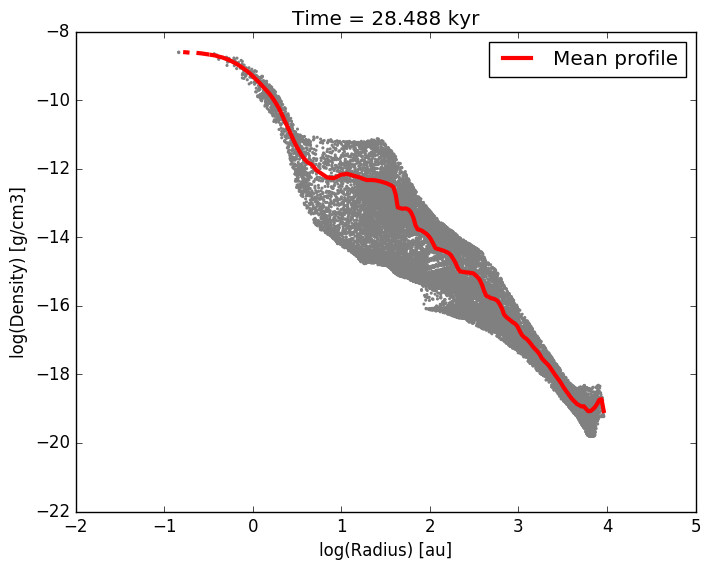
Updated